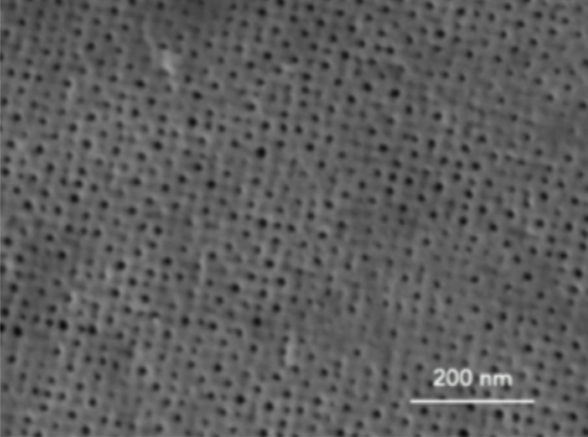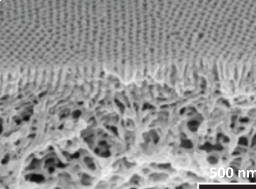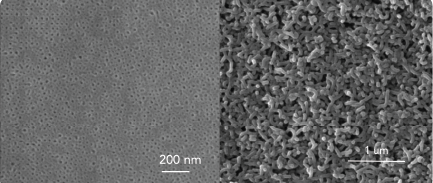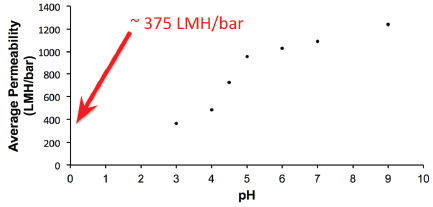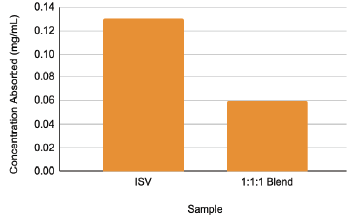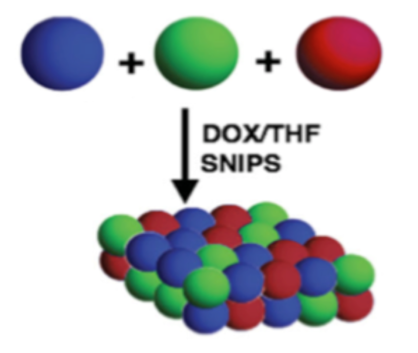Self-Assembling Block Co-Polymers
Design of tunable and selective ultra to nano filtration membranes for biological and protein filtration applications.
Materials Engineering
Wet Lab Research
Characterization and Testing
Duration
3 years
Recognition
Hunter R. Rawlings III Cornell Presidential Research Scholar,
Advanced Materials Fellowship Award,
Best Poster Award, ASEE
Collaborators
Dr. Yuk Mun Li,
Wiesner Lab
Ultrafiltration is process of separating certain organic molecules, viruses, and a range of salts. This research involved looking at how to incorporate certain desirable and tunable properties to ultrafiltration membranes such as high flux, high selectivity, and resistance to protein fouling. The goal was to be able to tune the membrane for more selective for complex filtrations. This is achieved by blending three tri-block terpolymers (ISV, ISO and SVPS) together in a 1:1:1 ratio, and casting in a non-solvent to form a porous membrane.
ISV: [poly(isoprene-b-styrene-b-4-vinyl pyridine)]
ISO: [poly(isoprene-b-styrene-b-ethylene oxide)]
SVPS: [poly(styrene-b-(4-vinyl pyridine)-b-(propylene sulfide))]
Background
Current ultrafiltration membranes on the market do not have a uniform top surface or exhibit selectivity and anti-fouling, which are desirable properties. Tri-block terpolymers have the ability to self-assemble into a hexagonal array as seen above. They can be used to fabricate ultrafiltration membranes.
The base polymer ISV has the ability to form a uniform top structure and pH dependent pore size. However, it has issues being used in certain applications due to protein fouling, and the inability to do more complex filtrations through surface functionalization, which is enabled by ISO and SVPS. In this work we blend 3 tri-block terpolymers to create a membrane that exhibits all these properties.
Contribution
ISV, ISO and SVPS are synthesized through anionic polymerization .I was responsible for creating the dope solutions of these three tri-block terpolymers, testing different ratios of blending, casting the solution to create membranes using the NIPS process, and material characterization.
Characterization & Outcomes
Definitions
1. Tri-block Terpolymers
A polymer comprising of a linear arrangement of three distinct blocks of molecules.
2. NIPS
Non-solvent induced phase separation is an industrial scalable method to produce asymmetric polymer membranes. It involves immersing a polymer solution in a non-solvent to induce phase separation which results in the self assembled pores of the membrane.
4. Flux
Rate of flow of solution being filtered through a membrane. Flux is maximized by high pore density. The triblock terpolymer ISV is used to achieve high permeability and pore uniformity during self assembly.
3. Self-Assembly
Self assembly is the autonomous ordering of components to form porous structures. Depending on the ratio of components, various morphologies can be achieved.
5. Selectivity
Selectivity is the ability to filter out certain molecules based on size or charge by controlling the membrane pore size or surface chemistry. The triblock terpolymer SVPS is used due to its ability to attach various functional groups to its chain ends through thiol click chemistry.
6. Protein Fouling
Anti-fouling is the ability to prevent large aggregates of proteins from attaching to the surface and clogging pores, and can be achieved by altering surface chemistry. The triblock terpolymer ISO is used due to its antifouling properties .
Sources
Peinemann, K.V., Abetz, V., & Simon, P.F.W., (2007), “Asymmetric superstructure formed in a block copolymer via phase separation”, Nature Materials, 6, 992-996.
W. A. Phillip, R. M. Dorin, J. Werner, E. M. Hoek, U. Wiesner, M. Elimelech, (2011) “Tuning Structure and Properties of Graded Triblock Terpolymer-Based Mesoporous and Hybrid Films", Nano Letters, 11, 2892-2900.
Y. M. Li, D. Srinivasan, P. Vaidya, Y. Gu, & U. Wiesner, (2016), “Asymmetric Membranes from Two Chemically Distinct Triblock Terpolymers Blended during Standard Membrane Fabrication”, Macromolecular Rapid Communications, 37, 20, 1689-1693.
Q. Zhang et al, (2016), “Dynamically Responsive Multifunctional Asymmetric Triblock Terpolymer Membranes with Intrinsic Binding Sites for Covalent Molecule Attachment.” Chemistry of Materials, 28, 11, 3870–3876.
Gu, Y. Wiesner, U. (2015). “Tailoring Pore Size of Graded Mesoporous Block Copolymer Membranes: Moving from Ultrafiltration toward Nanofiltration”. Macromolecules. doi: 10.1021/acs.macromol.5b01296

